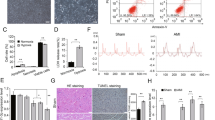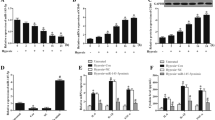Abstract
Myocardial hypoxia is a major cause of cardiac dysfunction due to its triggering cell injury and apoptosis. Deregulated microRNAs and their roles in cardiomyocyte apoptosis have attracted much attention. miR-133a is among the most abundant of the miRNAs present in the normal heart, and significant changes in expression of miR-133a were observed in response to anoxia stress. However, the role of this microRNA in myocardial hypoxia-induced apoptosis is presently unclear. In this study, we identified that miR-133a expression was down-regulated in hypoxic H9c2 cells, and its expression gradually decreased with hypoxia time. Functional analysis revealed that miR-133a attenuated hypoxia-induced apoptosis. We further detected expression of apoptosis-related proteins. The results showed that miR-133a suppressed the expression of apoptotic proteins caspase-8, caspase-9, and caspase-3 significantly, while improved the expression of Bcl-2. Bioinformatics analysis, combined with dual-luciferase reporter analysis, was applied to determine that miR-133a directly was binded to the 3′-untranslated region (3′-UTR) of TAGLN2 mRNA and suppressed expression at both transcriptional and translational levels. Next, TAGLN2 knockout was used to reveal that TAGLN2 modulated hypoxia-induced apoptosis via caspase-8 apoptotic pathway. Taken together, our data demonstrated the roles of miR-133a in hypoxia-induced apoptotic and implicate its potential in cardiac dysfunctions therapy.





Similar content being viewed by others
Abbreviations
- miRNA:
-
microRNA
- miR-133a:
-
microRNA-133a
- UTR:
-
Untranslated region
- TAGLN2:
-
Transgelin 2
References
Santos CX, Anilkumar N et al (2011) Redox signaling in cardiac myocytes. Free Radic Biol Med 50:777–793
Cassavaugh J, Lounsbury KM (2011) Hypoxia-mediated biological control. J Cell Biochem 112:735–744
Lu J, Getz G et al (2005) MicroRNA expression profiles classify human cancers. Nature 435:834–838
Johnson SM, Grosshans H et al (2005) RAS is regulated by the let-7 microRNA family. Cell 120:635–647
Harfe BD, McManus MT et al (2005) The RNaseIII enzyme Dicer is required for morphogenesis but not patterning of the vertebrate limb. Proc Natl Acad Sci USA 102:10898–10903
Hornstein E, Mansfield JH et al (2005) The microRNA miR-196 acts upstream of Hoxb8 and Shh in limb development. Nature 438:671–674
Harris KS, Zhang Z et al (2006) Dicer function is essential for lung epithelium morphogenesis. Proc Natl Acad Sci USA 103:2208–2213
Chen CZ, Li L et al (2004) MicroRNAs modulate hematopoietic lineage differentiation. Science 303:83–86
Drawnel FM, Wachten D et al (2012) Mutual antagonism between IP(3)RII and miRNA-133a regulates calcium signals and cardiac hypertrophy. J Cell Biol 199:783–798
Fang J, Song XW et al (2012) Overexpression of microRNA-378 attenuates ischemia-induced apoptosis by inhibiting caspase-3 expression in cardiac myocytes. Apoptosis 17:410–423
Hu S, Huang M et al (2010) MicroRNA-210 as a novel therapy for treatment of ischemic heart disease. Circulation 122:S124–S131
Zhou M, Cai J et al (2013) MiR-17-92 cluster is a novel regulatory gene of cardiac ischemic/reperfusion injury. Med Hypotheses 81:108–110
Bostjancic E, Zidar N et al (2010) MicroRNAs miR-1, miR-133a, miR-133b and miR-208 are dysregulated in human myocardial infarction. Cardiology 115:163–169
Dong S, Cheng Y et al (2009) MicroRNA expression signature and the role of microRNA-21 in the early phase of acute myocardial infarction. J Biol Chem 284:29514–29525
Qian L, Van Laake LW et al (2011) miR-24 inhibits apoptosis and represses Bim in mouse cardiomyocytes. J Exp Med 208:549–560
Rao PK, Missiaglia E et al (2010) Distinct roles for miR-1 and miR-133a in the proliferation and differentiation of rhabdomyosarcoma cells. FASEB J 24:3427–3437
Rao PK, Kumar RM et al (2006) Myogenic factors that regulate expression of muscle-specific microRNAs. Proc Natl Acad Sci USA 103:8721–8726
Biggar KK, Kornfeld SF et al (2012) MicroRNA regulation in extreme environments: differential expression of microRNAs in the intertidal snail Littorina littorea during extended periods of freezing and anoxia. Genomics Proteomics Bioinform 10:302–309
Liu B, Che W et al (2013) SIRT4 prevents hypoxia-induced apoptosis in H9c2 cardiomyoblast cells. Cell Physiol Biochem 32:655–662
Ji F, Zhang H et al (2013) MicroRNA-133a, downregulated in osteosarcoma, suppresses proliferation and promotes apoptosis by targeting Bcl-xL and Mcl-1. Bone 56:220–226
Afshari A, Uhde-Stone C et al (2014) Live visualization and quantification of pathway signaling with dual fluorescent and bioluminescent reporters. Biochem Biophys Res Commun 448(3):281–286
Doyle EL, Booher NJ et al (2012) TAL Effector-nucleotide targeter (TALE-NT) 2.0: tools for TAL effector design and target prediction. Nucl Acids Res 40:W117–W122
McCormick RI, Blick C et al (2013) miR-210 is a target of hypoxia-inducible factors 1 and 2 in renal cancer, regulates ISCU and correlates with good prognosis. Br J Cancer 108:1133–1142
Yuan S, Yu X et al (2011) The holo-apoptosome: activation of procaspase-9 and interactions with caspase-3. Structure 19:1084–1096
Wang K, Liu F et al (2013) miR-874 regulates myocardial necrosis by targeting caspase-8. Cell Death Dis 4:e709
Kang MH, Reynolds CP (2009) Bcl-2 inhibitors: targeting mitochondrial apoptotic pathways in cancer therapy. Clin Cancer Res 15:1126–1132
Yoshino H, Chiyomaru T et al (2011) The tumour-suppressive function of miR-1 and miR-133a targeting TAGLN2 in bladder cancer. Br J Cancer 104:808–818
Carlson DF, Tan W et al (2012) Efficient TALEN-mediated gene knockout in livestock. Proc Natl Acad Sci USA 109:17382–17387
Li P (2010) MicroRNAs in cardiac apoptosis. J Cardiovasc Transl Res 3:219–224
He S, Liu P et al (2013) miR-138 protects cardiomyocytes from hypoxia-induced apoptosis via MLK3/JNK/c-jun pathway. Biochem Biophys Res Commun 441:763–769
Suh JH, Choi E et al (2012) Up-regulation of miR-26a promotes apoptosis of hypoxic rat neonatal cardiomyocytes by repressing GSK-3beta protein expression. Biochem Biophys Res Commun 423:404–410
Kuwabara Y, Ono K et al (2011) Increased microRNA-1 and microRNA-133a levels in serum of patients with cardiovascular disease indicate myocardial damage. Circ Cardiovasc Genet 4:446–454
He B, Xiao J et al (2011) Role of miR-1 and miR-133a in myocardial ischemic postconditioning. J Biomed Sci 18:22
Shan YX, Liu TJ et al (2003) Hsp10 and Hsp60 modulate Bcl-2 family and mitochondria apoptosis signaling induced by doxorubicin in cardiac muscle cells. J Mol Cell Cardiol 35:1135–1143
Tang Y, Zheng J et al (2009) MicroRNA-1 regulates cardiomyocyte apoptosis by targeting Bcl-2. Int Heart J 50:377–387
Xu C, Lu Y et al (2007) The muscle-specific microRNAs miR-1 and miR-133 produce opposing effects on apoptosis by targeting HSP60, HSP70 and caspase-9 in cardiomyocytes. J Cell Sci 120:3045–3052
Tu S, Liu ZQ et al (2012) Inhibitory effect of p53 upregulated modulator of apoptosis targeting siRNA on hypoxia/reoxygenation-induced cardiomyocyte apoptosis in rats. Cardiology 122:93–100
Author information
Authors and Affiliations
Corresponding author
Rights and permissions
About this article
Cite this article
Li, Ay., Yang, Q. & Yang, K. miR-133a mediates the hypoxia-induced apoptosis by inhibiting TAGLN2 expression in cardiac myocytes. Mol Cell Biochem 400, 173–181 (2015). https://doi.org/10.1007/s11010-014-2273-2
Received:
Accepted:
Published:
Issue Date:
DOI: https://doi.org/10.1007/s11010-014-2273-2




